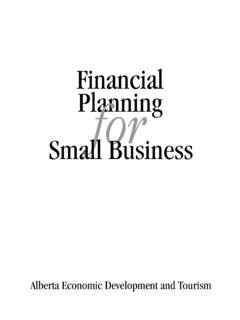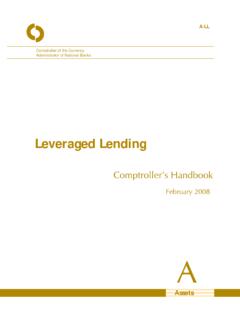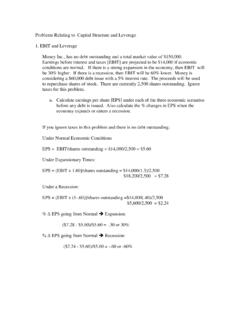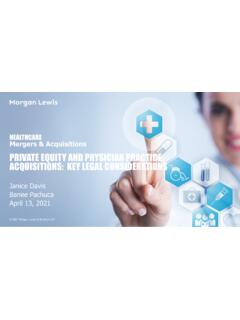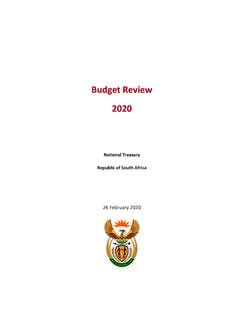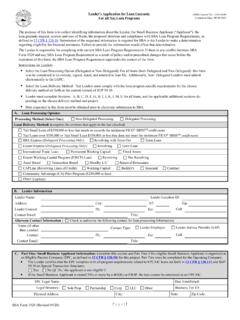Transcription of Some common mistakes - Deloitte
1 Some common mistakes to avoid in estimating and applying discount ratesDeloitte | A Middle East Point of View | Spring 2014| 37 Discount ratesOne of the most critical issues for an investor toconsider in a strategic acquisition is to estimate howmuch the company being acquired is worth. On theback of the 2008 financial crisis, a valuation is beinglooked at not just as a static value at a point in time,but more as a basis for developing a post-acquisitionoperation plan to drive value accretion andminimizing risk. As such, the Discounted CashFlow (DCF) analysis is being more frequently usedto value companies.
2 Ke = Rf + (RPm + RPi) + RPs + CRP + RPz (based on the Build-up approach)(based on the CAPM approach)Rf = risk-free rate, RPm = market premium, RPi = industry premium, RPs = size premium, CRP = country risk premium, RPz = company specific risk and = betaKe = cost of equity , Kd = after tax cost of debt ,We and Wd = proportion of equity / debt based on market valueKe = Rf + ( x RPm) + RPs + CRP + RPz WACC = Ke x We + Kd x Wd38| Deloitte | A Middle East Point of View | Spring 2014 The discount rate is an essential component of the DCF-based valuation, which can be tricky to get right.
3 In this article, we explore the reasons why estimateddiscount rates may differ between practitioners. We also provide an overview of some of the commonmistakes to avoid in estimating and applying There are varying approaches to determining a discount rate The discount rate is an investor s desired rate of return,generally considered to be the investor s opportunitycost of capital. The Weighted Average Cost of Capital (WACC) represents the average cost of financing acompany debt and equity , weighted to its respective use. Essentially, the Keconsists of a risk free rate of returnand a premium assumed for owning a business and canbe determined based on a Build-up approach or CapitalAssets Pricing Model (CAPM).
4 While both theseapproaches should theoretically result in the samediscount rate, in practice the estimated discount rates will differ between companies, markets andgeographical areas due to judgments by differentvaluators around some of the key components of the discount using nominal 10-year treasury bondInflation differential Risk-free rateUnlevered betaD/ETax rate (assumed nil for as well)Levered betaMarket risk premium Country risk premium UAESize & specific risksCost of equity (rounded)After tax cost of debt (Kd)WACC 5%0% 5%0% | A Middle East Point of View | Spring 2014| 392.
5 Estimating the Keis subjectiveWhile the Kd(after tax cost of debt ) is relatively easy to determine, in estimating the Kethere are differingperspectives amongst valuators on certain of its keycomponents. Summarized below are some of theseareas of judgment that may result in different discount rates: Risk-free rate (Rf):Government bonds are generallyused as reference for deriving the Rf. However, weoften notice valuation practitioners using the bondswith varying durations ( , 10, 20, 30 years) as aproxy for Rf, resulting in a difference in the discountrate. The selected Rf should match the duration of the underlying cash flows.
6 In practice the estimated discount rateswill differ between companies, marketsand geographical areas due to judgmentsby different valuators around some of thekey components of the discount rateIllustrative Example (WACC calculation)Let us walk through an example. Assume that an investor intends to value a private companyABC & Co that operates schools in the United Arab Emirates and the United States. The common approach tocalculate a WACC would be as follows:Notes:1. Inflation differential based on the Economist Intelligence Unit long-term forecast2. Beta and debt / equity based on Morningstar industry beta for educational services sector3.
7 Market risk premium based on historical implied risk premium on equity market4. Country risk premium sourced from Prof. Damodaran s research based on sovereign credit rating by Moody s5. Industry risk premium sourced from SBBI Valuation Essentials handbook6. Size and specific risk as per judgment based on market dynamics, school operations, competitive advantage, etc. As this is subjective, itwould be appropriate to apply a range of values, thus arriving at a range of WACC using nominal 10-year treasury bondInflation differential Risk-free rateMarket risk premium Country risk premium UAEI ndustry risk premiumD/ESize & specific risksCost of equityAfter tax cost of debt (Kd)WACC ratesExample (estimating Ke)Risk-free rateThe nature of ABC & Co is such thatoperations are expected to be for an indefiniteperiod.
8 As such, longer maturity as proxy forRf is more appropriate ( , a 30-yearmaturity treasury bond with a yield of 3% will result in a higher WACC).BetaThe number of companies listed on the UAEstock exchanges, and data thereof, are the beta of public comparablecompanies within the same country/regionshould be used, we have used an industrybeta based on developed markets. In theeducational sector, the beta of developed andemerging markets is the risk premiumLet us now assume that the operations in theUnited Arab Emirates include revenue derivedfrom international activities in the UnitedStates. As such, the UAE business is not 100percent exposed to local country risk.
9 Oneapproach may be to adjust the total CRPbased on the CRP portion of the total earningsthat are exposed to local country risk (say 80percent adjustment for ABC & Co).40| Deloitte | A Middle East Point of View | Spring 2014 Beta ( ):The represents the correlation of industryor business sector with the economy. A challenge inthe Middle Eastern region is the lack of liquidity in thelocal markets and inadequate data for the correlationanalysis. This has resulted in practitioners relying on determined from different sources (such as Damodaran s publications) and personalexperience and judgment.
10 Country risk premium (CRP):When estimating the Kebased on data from a developed market, anadjustment needs to be considered for the countryrisk. While there is some convergence amongstvaluators on how to determine the CRP, there is adifference of opinion on if and how to adjust the totalCRP to reflect a company s exposure to country risk. The discount rate is applied todetermine the present value of futurecash flows and represents the investor sappetite for risk and the underlyinguncertainties in the cash flows. Thehigher the implied risk the higher thediscount rate is and the lower thevalue, and vice | A Middle East Point of View | Spring 2014| 413.










